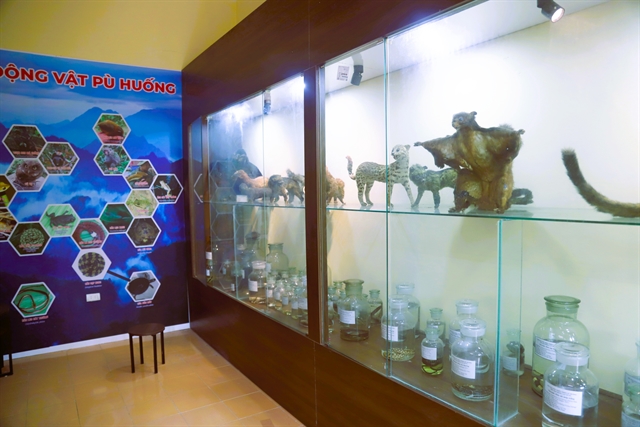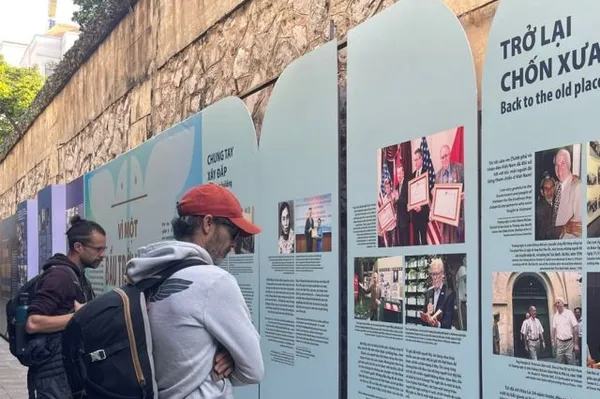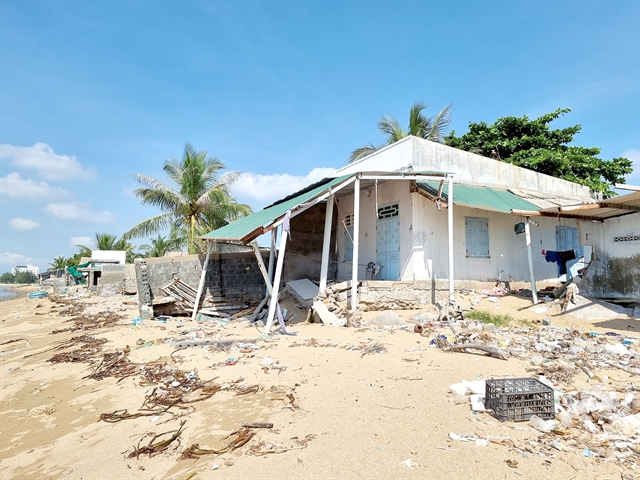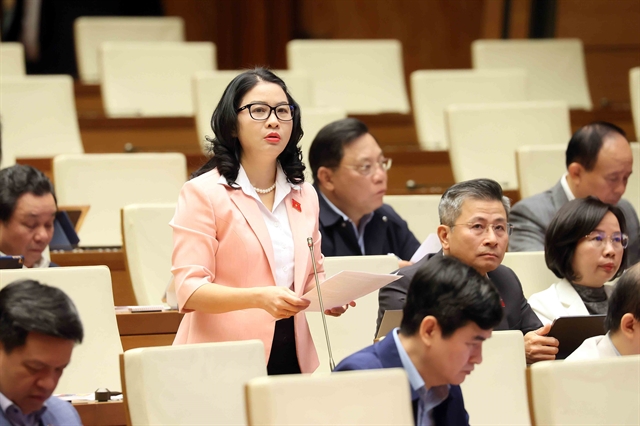 Environment
Environment

 |
| Catherine Stewart, Climate Change Ambassador of Canada.— Photo courtesy of the Embassy of Canada to Việt Nam |
Catherine Stewart, Climate Change Ambassador of Canada, talked to Việt Nam News reporter Nguyễn Hằng during her recent visit about Canada’s plans to support Việt Nam to adapt to climate change as well as in implementing the green transition process in the future.
What are Canada’s initiatives and commitments to global climate action?
Climate change is a global problem which requires a global solution. We are doing a lot domestically to tackle climate change and we are also doing a lot to support developing countries in addressing climate change. So domestically, we have net zero by 2050 in our legislation, and we have committed to establish plans every five years to support that goal with net zero by 2050. Right now, we have an emissions reduction plan as part of that, which is our nationally determined contribution (NDC), a commitment to reduce emissions by 40 per cent to 45 per cent by 2030. We have around 140 measures that we are implementing to address climate change. We have invested already about US$120 billion within Canada to address climate change.
Some of the initiatives that we are advancing in Canada include a commitment to phase out inefficient fossil fuel subsidies. We also have a commitment to phase out unabated coal for power. We are advancing clean fuel regulations and clean electricity regulations so that by 2035, our electricity bridge can be 100 per cent clean. We are also advancing zero emission vehicles, regulations and support for that. More recently, we announced a framework to put a cap on oil and gas emissions. Then we have got work on methane as well, including regulations to reduce emissions in the oil and gas sector by 75 per cent, reducing those methane emissions. So, we are doing a lot domestically to try to reduce emissions and adapt to climate change.
Canada also feels the impacts of climate change and we have a national adaptation strategy, which helps communities be more resilient to those impacts and to adapt to climate change. Our approach to climate change globally also includes support to developing countries. Canada has committed $5.3 billion in climate finance and we are advancing a number of initiatives under our climate finance support, including a billion dollars towards energy transition.
For Canada, we feel strongly we are addressing a triple crisis, a climate crisis against biodiversity loss and pollution. Top of our efforts on climate change, we have also played an instrumental role in biodiversity by working closely with China in hosting the COP15, the biodiversity Convention, and which concluded the Kunming-Montreal Global Biodiversity Framework. We will host the negotiating session this year, the INC-4 (the fourth session of the Intergovernmental Negotiating Committee to develop an international legally binding instrument on plastic pollution, including in the marine environment). It is called towards a global plastics agreement that we hope to conclude by the end of this year. Canada’s Minister of Environment and Climate Change Steven Guilbeault has also been very strongly advocating for climate finance and ensuring that we have the support that is needed for developing countries as we move into the future.
How do you evaluate past cooperation between Việt Nam and Canada?
The ties between our two countries are very deep. We have over 50 years of established diplomatic relations and over 30 years of Canada being able to support Việt Nam’s development assistance. We have invested over $1.8 billion in development assistance with Việt Nam. We really use that to support reducing poverty and inequality, empowering women and girls, and addressing climate change, including inclusive governance. We really look forward to continuing the great cooperation that we have established with Việt Nam.
Part of the reason I am here is to advance our Indo Pacific strategy, which is a concerted effort by the Government of Canada to deepen our ties in this region, but also deepen our cooperation with Việt Nam. We are very committed to supporting and promoting sustainable development and resilience in this region and in Việt Nam. We hope that both of our nations can continue to be very active globally on climate change and on sustainable development.
Vietnamese farmers are facing many problems related to climate change adaptation, for example, coastal communities in Việt Nam are suffering from major erosion due to rising sea levels. How will Canada support Việt Nam in handling these issues in the future?
 |
| A house in Ninh Chữ 1 Street, Khánh Hải Town, in the coastal central province of Ninh Thuận is damaged due to rising sea levels and seawater erosion.—VNA/VNS Photo Nguyễn Thành |
Adaptation is certainly a priority for Canada. I spoke a lot about our efforts domestically to reduce emissions, but we also need to build strong communities and be able to better adapt to the impacts of climate change. We are feeling the impacts of climate change in Canada. You may be aware of the wildfires that we had last summer in Canada, which burned an area, a total of 18.5 million ha, which is not insignificant. That is equal to about half the land mass of Việt Nam on fire in Canada. So we feel very, very strongly of the need to address climate change, given the impact on economies, but on people’s livelihoods.
We also know that those impacts are felt here as well, and that there are implications to Việt Nam’s GDP, including a cost of about 12 to 14 per cent to Việt Nam’s GDP by 2050, given the impacts of climate change. We really want to make sure that we are supporting communities in better being able to respond to the effects of climate change and build communities so that they can thrive in generations to come. That is why adaptation is really a key part of the Paris agreement.
We have mitigation, adaptation and providing support for the most vulnerable of this world. We know, for example, in Việt Nam, that rising sea levels pose a very significant threat, including in the Mekong Delta. We are very committed to help to support that. In the past, we have supported through the Asian Development Bank, a project on integrated disaster risk management and that established an integrated disaster risk management fund to support the development for innovative approaches and tools to manage disasters. We really hope to further adaptation and resilient projects with Việt Nam. We have several plans in place to do that, and then on agriculture as well. We have had some excellent cooperation on food security and on trade policy. We also look forward to being able to adopt more projects on that front as well.
Under the Just Energy Transition Partnership (JETP) agreement, G7 countries, including Canada, are mobilising US$15.5 billion from the private sector and the Government to support Việt Nam’s green transition process. Could you tell us about Canada’s support to help Viêt Nam achieve its net zero emissions target by 2050?
As I mentioned with Canada’s climate finance, energy transition is a very important component of that. Canada, for example, in 2019, was able to support Việt Nam in energy transition through our contribution that we made to the Asian Development Bank of $15 million to support Việt Nam’s first floating solar project. Then at COP 26, we were very pleased to see Việt Nam’s commitment to net zero by 2050, the commitment to stop deforestation by 2030, and also the commitment to phase out coal fuelled power generation by 2040. So with that commitment, we are very pleased that the international community, through the International Partners Group (IPG), was able to work with Việt Nam in developing a just energy transition partnership. I feel it is a very good example to the world of how a country with big needs to reduce emissions can work together on a plan to take that forward.
We have a number of projects over the next few years that we are eager to bring forward to support Việt Nam in your energy transition, including $50 million, which we have put forward to the World Bank, but also efforts within the International Energy Agency, the Organisation for Economic Co-operation and Development (OECD) and the Southeast Asia Energy Transition Partnership.
So a number of these projects would help Việt Nam boost their regulatory capacity, build capacity as well as analysis in order to be able to carry forward with the energy transition. We have also invested a billion dollars in the climate investment funds accelerating full transition. We are looking forward to using some of that funding that we have set aside to support Việt Nam in this effort. So, we are very excited about moving forward with this JETP and starting to implement some projects.
Canada has promoted a global carbon pricing initiative to create a forum for countries that have established carbon markets as well as countries interested in this issue to exchange experiences and increase technical support with the goal that 60 per cent of global carbon emissions would be priced by 2030. What is Canada doing to support other countries, including Việt Nam, to develop and implement carbon pricing?
One of the things that I have been doing while I have been here is advocating for the global carbon pricing challenge, which was initiated by Canada’s Prime Minister Justin Trudeau a couple of years ago. It really is an initiative, which aims to promote the value of carbon pricing as a policy tool that can effectively drive down emissions, promote innovation, promote energy efficiency and affordability.
We are looking for partners in the challenge and we really look forward to, hopefully, Việt Nam joining the challenge very soon to show leadership and support around this policy tool. As you mentioned, the aim of the challenge is to bring more of global emissions under carbon pricing regime. Right now, we have about 23 per cent of global emissions covered under some kind of carbon pricing regime. We want to bring that to 60 per cent by 2030. So we are working very hard on that goal and gathering more partners, showing that global leadership to do that.
The other opportunity within the global carbon pricing challenge is to provide technical support and help countries build the capacity and technical ability to be able to manage carbon pricing. We are really looking forward to offering that technical support to Việt Nam but also to other countries that are interested in implementing their own carbon pricing systems.
There is a lot of experience and knowledge out there and opportunities to be sharing lessons learned and best practices on carbon pricing. This is an area where we see Việt Nam playing a big leadership role, having implemented emissions trading system and a leadership role also within ASEAN, which is why Canada’s Prime Minister Trudeau is very keen to see Việt Nam join the partnership and he has reached out on this front already. So we look forward to working with Việt Nam on that.— VNS




